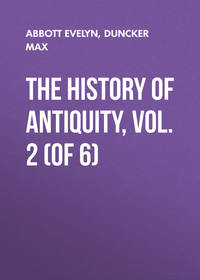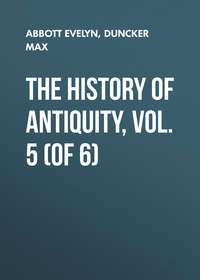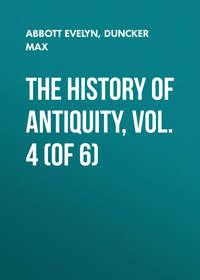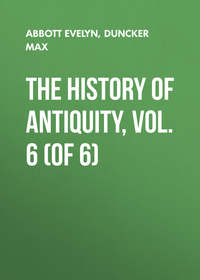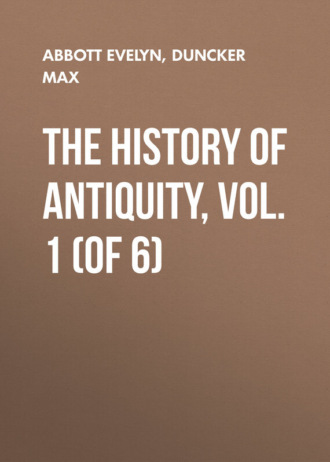 полная версия
полная версияThe History of Antiquity, Vol. 1 (of 6)
601
Gen. xiv. 6; Deut. ii. 12, 22.
602
Gen. xxviii. 1-9; Gen. xxxvi. 3, 10, calls the daughter of Ishmael, Basmath; cf. supra, pp. 317, 406.
603
Gen. xlviii. 1. On the places of worship at Beersheba and the "heights of Isaac" in Amos, cf. A. Bernstein, "Ursprung der Sagen," s. 14, 15.
604
Nöldeke, "Untersuchungen," s. 32.
605
De Wette-Schrader, "Einleitung," s. 273 ff.
606
Ebers, "Durch Gosen," s. 430; "Ægypt. und die Bücher Moses," s. 330, 323 ff.
607
Ebers, "Ægypt. und die Bücher Moses," s. 321, 322.
608
Above p. 196; Ebers, loc. cit. s. 347.
609
Lepsius, "Chronol." s. 382; Ebers, "Ægypten und die Bücher Moses," s. 296; Lauth, "Moses," s. 77.
610
Exod. xii. 40.
611
Ebers, "Durch Gosen," s. 505 ff.
612
Generally only two or three. The longest genealogy is that of Joshua: Ephraim, Beriah, Rephah, Telah, Tahan, Laadan, Ammihud, Elishama, Nun (1 Chron. vii. 20 ff; cf. Numb. xxvi. 35; vii. 48; x. 22), from which, if it were to be regarded as certain (Ewald, "Gesch. Israel's," 1, 490, thinks that it is certain), it would follow that the Hebrews were over 200 years in Egypt, assuming 25 years as the length of a generation.
613
1 Kings vi. 1.
614
Lepsius, "Chronolog." s. 365. On the possible twelve representatives of those twelve generations, Nöldeke, "Untersuchungen," s. 190.
615
Exod. i. 11; Gen. xlvii. 11.
616
Exod. v. 6-11.
617
Exod. i. 7, 13, 14.
618
Chabas, "Mélang. égypt." pp. 2, 42 ff. That lutu means "Egyptians," as Ebers ("Ægypt." s. 96) thinks, is by no means certain.
619
Ebers, "Durch Gosen." p. 494.
620
Lauth, "Moses," s. 1.
621
Exod. i. 10.
622
Exod. xii. 37. Numb. i. 46.
623
"With 600,000 men, besides the children," Exod. xii. 37, 38. Numbers i. 22-46, enumerates 603,550 fighting men, who could take the field, in the total sum, and in the totals for the several tribes, to which must be added 22,000 male Levites, men and boys, Numb. iii. 39. The question seems to me to be settled by Nöldeke ("Untersuchungen," s. 117).
624
1 Chron. vi. 18.
625
Above, p. 409; Gen. xxxv. 22.
626
Gen. xxxiv. 13, 25-30, xxxviii.
627
De Wette-Schrader, "Einleitung," s. 280, n. 54.
628
Gen. xlviii, 20.
629
Gen. xlviii. 5; above, p. 425.
630
Exod. xv. 1-11; cf. Joshua xxiv. 7.
631
Nöldeke, "Untersuchungen," s. 40.
632
Exod. i. 1-7, 13, 14; ii. 23, 24; vi. 2-7, 9-27; vii. 8-13, 19-22; viii. 1-4, 12-15; ix. 8-11; xii. 1-23, 37, 40-51; xiii. 20; xiv. 8, 9, 15-17, 21-23, 29.
633
Exod. xiii. 2; xxii. 29, 30; xxxiv. 19, 20. "The firstborn of thy sons thou shalt give to me. Likewise shalt thou do with thine oxen, and thy sheep. All that openeth the matrix is mine, all thy cattle that is male. All the firstborn of thy sons thou shalt redeem." Cf. Exod. xxx. 11-16.
634
Ewald, "Alterthümer des Volkes Israel," s. 358 ff.
635
De Wette-Schrader. "Einleitung," s. 282, 284, 290.
636
Lepsius, "Briefe," s. 46, 47.
637
Ebers. "Durch Gosen." s. 101 ff.
638
Nöldeke. "Untersuchungen," s. 47. According to De Wette-Schrader, from the second text ("Einleitung," 283), verses 11-17 may be an addition; verses 19-21 obviously come from the revision.
639
Exod. ii. 19.
640
Büdinger ("Akad. d. Wissenschaft zu Wien," Sitzung vom, 15 October, 1873) regards Moses and Aaron as of Egyptian origin, as Egyptian priests, and finds the tribe of Levi in the leprous Egyptians who went out with the Hebrews. Lauth ("Moses der Hebraeer," and "Zeitsch. d. d. M. G." 1871, s. 135 ff) inclines to recognise Moses in the mohar, sotem (scribe) and messu of the papyrus Anastasi I., who would thus have been one of the Egyptian scholars, and employed by Ramses II. in matters of state and war. This view is opposed by Pleyte ("Zeitschr. f. aeg. Sprache," 1869, s. 30, 100 ff.); he reads the name Ptah-messu. Lauth, at the same time, refuses to derive the name Osarsiph from Osiris; he considers it to be Semitic, and explains it as a-sar-suph, i. e. "rush-basket."
641
Lepsius, "Königsbuch der Ægypten," s. 117-150. Maspero objects that Egypt in the time of Menephta was still too powerful for the Israelites to carry out their exodus. Such a plan was possible for the first time in the last years of Sethos II. (above, p. 150), or shortly after his death ("Hist. Ancienne," p. 259). These considerations are of too general a nature to allow any definite conclusions to be founded upon them; and if Josephus or his copyist changed the Menephtes of Manetho into the much better known Amenophis, or mistook one for the other, a similar interchange cannot so easily be assumed for the names Sethos and Menephtes.
642
Gen. xxxvi. 31-39; Nöldeke, "Untersuchungen," s. 87.
643
Diod. 40, frag. 3.
644
Diod. 34, frag. 1.
645
Strabo, p. 760, 761.
646
Fragm. 30, ed. Müller.
647
Justin. "Hist." 36, 2.
648
Joseph. "c. Apion." 1, 34.
649
"Hist." 5, 2-5.
650
Numb. xxiv. 13, c. xxxi.
651
Numb. xxxii. 4; Nöldeke, "Untersuchungen," s. 90.
652
De Wette-Schrader, "Einleitung," s. 292; Nöldeke, "Untersuchungen," s. 86.
653
2 Kings xviii. 4.
654
Numb. xx. 1-13, 22-29; Deut. xxxii. 48-52.
655
Lepsius, "Briefe," s. 245.
656
Isaiah xv. 8.
657
On the mutual interpolations of the narratives, both in regard to the rebels and the mode of their destruction, see Nöldeke, "Untersuchungen," s. 79, 131.
658
Lepsius, "Briefe," s. 341.
659
Numb. xxxiii. 40 (the first text); Numb. xxi. 1-3, and xiv. 44, 45, belong to the second text; De Wette-Schrader, "Einleitung," s. 291; Deut. i. 44; Joshua xii. 14; Judges i. 17. Cf. Nöldeke, "Untersuchungen," s. 85, on the tenacity with which unsuccessful battles are remembered in these districts.
660
Nöldeke explains Exod. xx. 23-26 and xxi. 1-xxiii. 19, as in substance and in part a composition of great antiquity, "Untersuchungen," s. 51.
661
Nöldeke ("Untersuchungen," s. 62 ff.) proves that Levit. i. – xxvi. 2, and xxvii., with the exception of a few additions, especially cc. xviii. – xx. belong to the first text; and De Wette-Schrader ("Einleitung," s. 286 ff.) proves the same for nearly the whole book. Moreover, he shows at length, pp. 265, 266, that many of the ceremonial ordinances and the faith of the land in general goes back to Moses, or the Mosaic times.
662
The Mosaic origin of the decalogue (Exod. xx. 1-17; Deut. v. 6-21) is proved in De Wette-Schrader, "Einleitung," s. 284. The original form of it, it is true, is no longer in existence.
663
So the old codex, Exod. xxi. 1-6. The priestly law on the other hand puts off the liberation till the year of Jubilee, Levit. xxv. 39 ff.
664
On Exod. xxi. – xxiii. 19, cf. De Wette-Schrader, "Einleitung," s. 285, 286, and Nöldeke, "Untersuchungen," s. 51, 63 ff.
665
Gen. xlvi. 8-27 Numb. ii 3-31; 1 Chron. ii 10.
666
Nöldeke, "Untersuchungen," s. 103, 109, 128.
667
That the chronological statements in the book of Judges afford no fixed point for deciding the date of the invasion of Canaan by the Hebrews is proved by Nöldeke ("Chronologie der Richterzeit"). The genealogical tables give only six or seven generations down to Eli and Samuel, and these cannot fill a longer space than of 150 to 175 years. As Ramses III. whose reign according to Lepsius falls in the years 1269-1244 B.C. fought against the Pulista, Cheta, and Amari, i. e. the Philistines, Hittites, and Amorites, within the first nine years of his reign (p. 164) without meeting the Hebrews among them, we may assume that their settlement in Canaan did not take place till after the year 1260 B.C., about the middle of the thirteenth century, B.C.
668
Cf. Nöldeke, "Untersuchungen," s. 95.
669
Lev. xxvii. 28, 29.
670
In the form of a vow, Numb. xxi. 1-3, from the second text; in the form of a command, Exod. xxiii. 32, 33; xxxiv. 12, from the revision.
671
If the Hivites are counted in 2 Samuel xxi. 22 among the Amorites, the reason is to be sought in the comprehensive meaning here given to the name Amorites.
672
2 Sam. xxi. 1-10; 1 Kings ix. 20; cf. Joshua xvii. 12.
673
De Wette-Schrader, "Einleitung," s. 304, 305; Nöldeke, "Untersuchungen," s. 98.
674
Joshua xi. 1, 10, 13; xii. 19; xix. 36; Judges iv. 2, 17; 1 Sam. xii. 9
675
1 Sam. xxi. 1-6; xxii. 11-18.
676
Joshua xii.; Nöldeke, "Untersuchungen," s. 98.
677
Judges i. 27-30.
678
Judges i. 16; iii. 13.
679
Joshua xix. 49, 50; xxiv. 33, both from the first text; Joshua xvii. 14-18.
680
Joshua xvii. 14-18.
681
Judges i. 7.
682
Judges i. 12-15, 20; Jesus, 46, 11.
683
Judges i. 19.
684
Joshua xix. 47; Judges xviii.
685
Judges i. 22, 29.
686
Judges i. 27.
687
Judges i. 30-35.
688
Strabo, pp. 525, 530, 532, 559.
689
Kiepert, "Monatsberichte der B. Akad.," 1869, s. 238.
690
Kiepert, loc. cit. s. 239.
691
Von Gutschmid, "Sächs. Gesell. d. W." 1876, p. 5, seqq.
692
Mos. Chor. 1, 10-22.
693
Mos. Chor. 1, 23-30.
694
Kiepert, "Monatsberichte der B. Akad.," 1869, s. 222.
695
Kiepert, loc. cit. s. 236.
696
Kiepert, "Monatsberichte der B. Akad.," 1869, s. 226.
697
Jer. li. 27; Ezek. xxvii. 14; xxxviii. 6.
698
Moses Chor. c. 24-30, in Le Vaillant's translation.
699
Anab. 4, 5.
700
G. Rawlinson, "Monarch.," 2, 64, 79; Ménant, "Annal.," pp. 49, 64, 73, 82.
701
G. Smith, "Zeit. fur. ægypt. Sprache," 1869, s. 9-13, 98.
702
Oppert, "Inscript. des Sargonid.," p. 22, et seq., 37; "Inscript. de DurSarkayan", pp. 14, 21. G. Rawlinson, "Monarchies," 2, 188. According to Oppert's reading the two gods of Arsissa were called Haldia and Bagabarta.
703
Joseph. "Antiq.," 1, 3, 6; Kiepert, "Monatsberichte der B. Akad.," 1869, s. 236.
704
G. Smith, "Assurb.," 61, 75, 84 seqq.
705
Botta, "Monum. de Ninive," 2, pl. 140, 141.
706
Lenormant, "Lettr. Assyr." 1, 121, 142, reads Belitdur and Menuas Hincks read Niriduris and Kinuas.
707
Mordtmann, "Zeit. d. d. M. G.," 26, 484 ff.
708
Herod. 7, 73; 8, 138.
709
Strabo, p. 471.
710
Herod. 7, 75; Thucyd. 4, 75; Xenoph. "Anab." 6, 4, 2; Strabo, p. 541, 542.
711
Otto Abel, "Makedonien," s. 57 ff.
712
Lassen, "Zeit. d. d. M. G.," 10, 369 ff.
713
Herod. 2, 2.
714
Justin, "Hist.," 11, 7; Plut. "Alex.," c. 18; Arrian, "Anab.," 2, 3; Steph. Byzant, Γορδίειον; Pausan. 1, 4, 5.
715
Aristoph. "Plut.," 287; Ovid, "Metamorph.," 11, 146.
716
Arist. "Pol." 8, 55.
717
Diod. 3, 59.
718
Herod. 7, 26; Xenoph. "Anab." 1, 2, 8.
719
Fragm. 128, ed. Müller.
720
A communication from Kiepert.
721
Pollux, 9, 83; Heracl. Pont. Fragm. 11, ed. Müller.
722
Euseb. "Chron." 2, 82, ed. Schöne.
723
[Plato, "Phaedr." 264 D. (Jowett.)]
724
Diog. Laert. 1, 89; Simonid. Fragm. 57, ed. Bergk; Herod. 1, 14, 35; Strabo, p. 61; "Bergk-Griech. Litteratur-Gesch." 1, 779. The date of the second Midas is fixed by the observation of Herodotus that the dedicatory offerings of Midas were older than those of Gyges, and by the date of the first invasion of the Cimmerians, which will be ascertained below: the second invasion of the Cimmerians took place far later, in the time of Ardys of Lydia, i. e. at a time when monarchy was no longer in existence in the Greek cities. Hence I believe that the Midas of the tomb must be distinguished from the Midas of the dedicatory offering.
725
The upper inscription of this tomb is as follows: "Ates arkiaevos akenanogavos Midai lavaltaie vanaktei edaes;" the lower is: "Baba memavais proitavos kphizan avozos sikeman edaes." – Leake, "Asia Minor," p. 22-36; Barth, in Petermann "Geog. Mittheilungen," 1860, s. 91-93; Lassen, in "Zeit. d. d. M. G." 10, 372. For "lavaltaie" R. Stuart reads "na-" or "gavaltaie."
726
Strabo, p. 569; Vitruvius, 2, 1, 5.
727
Perrot, "Exploration," pp. 218, 224.
728
Hamilton, "Asia Minor," 1, 95-98, 401, 451; 2, 233-252.
729
Lucian, "Jup. Trag." c. 8. 42.
730
Etym. Magn. Ἄμμα.
731
Diod. 3, 59; Livy, 29, 14.
732
Arist. "Rhet." 3, 2; Ovid. "Fast." 4, 265; Arnoh. "Adv. Gent." 9, 5, 4.
733
Diod. 3, 59.
734
Herod. 1, 94. In Hippolytus ("Philosoph." 5, 9, p. 118, ed. Miller) Atys is called the sun of Rhea. Agdistis appears to have been androgynous; Paus. 7, 17, 5. Hesych. Ἄγδιστις. The chief priests at Pessinus were always called Atys, according to the inscriptions of Sivrihissar, cf. Polyb. 22, 20.
735
Plut. "De Isid." 69.
736
Arnob. "Adv. Gent." 5, 16; Herodian, 1, 10.
737
Hippolyt. loc. cit., p. 119.
738
"Il." 3, 187; Hym. Ven. 112.
739
"Bacch." 55 ff., 120 ff.; Diod. 3, 57.
740
Herod. 1, 173, and H. Stein ad loc.; Chœrilus in "Joseph. c. Apion." 1, 22.
741
"Anab." 1, 2, 21 ff.
742
Blau, "Num. Achaem. Aram-persic," p. 5.
743
Lassen, "Zeit. d. d. M. G." 10, 385.
744
Herod. 7, 91; 5, 118; 7, 98; Xenoph. "Anab." 7, 8, 25.
745
H. Stein, on Herodotus, 1, 74.
746
Hellan. fragm. 158, ed Müller.
747
Berosi Fragm. 12, ed. Müller; Abyd. Fragm. 7, ed. Müller. That Anchialensium should be read instead of Atheniensium need not be proved at length.
748
Arrian, "Anab." 2, 5; Athen. p. 529; Steph. Byz. Ἀγχιάλη.
749
Ménant, "Annal." pp. 107, 228, 231, 242; G. Smith, "Assurbanipal," p. 62.
750
Æsch. "Persae," 326; Herod. 3, 90; 7, 91, 98; Xenoph. "Anab." 1, 2, 12.
751
Brandis, "Münzwesen," s. 348 ff., 354, 497 ff., 574.
752
1, 72; cf. 5, 62.
753
"Il." 2, 857.
754
"Prom. Vinct." 613-617.
755
Sandwich, "Siege of Kars," p. 35 of translation. On the Murad Tshai, near Charput, the best iron is still procured.
756
Herod. 1, 72; 7, 72.
757
Fragm. incert. 150, ed. Bergk.
758
Scymn. Ch. 943.
759
"Peripl. P. E." c. 20, ed. Müller.
760
Plut. "Lucull," 23.
761
C. 89, 90.
762
Strabo, p. 533, 544, 737; cf. Schol. Apoll. Rhod. 1, 948.
763
Brandis, "Münzwesen," 308, 427; Blau, "Phœniz. Münzkunde," 2, 12, 19. These, and the reasons given above, seem to me sufficient to prevent my agreeing to Lassen's opinion ("Zeit. d. d. M. G." 10, 377) that the Cappadocians were an Indo-Germanic tribe.
764
Herod. 4, 1, 10-12; 1, 103, 104.
765
"Odyss." 11, 14-19.
766
"Ranae," 187.
767
Scym. Ch. 239, 240; Strabo, 244; Virgil, "Aen." 3, 441; Plin. "Hist. Nat." 3, 9.
768
Callinus, apud Strabo, 648; Herod. 1, 6, 15, 16; 4, 12.
769
Aristot. apud Steph. Byz. Ἄντανδρος: Scymn. Ch. 941.
770
Τρῆρες.
771
Strabo, p. 61, 552, 494. On p. 647 we find "The Treres, a Cimmerian nation."
772
Strabo, p. 552.
773
Strabo, p. 20, 149, 573.
[A] Strabo, p. 61.
774
Strabo, pp. 627, 647, 61. That in this passage, where Madys is mentioned a second time with the epithet: the Cimmerian, Σκύθης must be read instead of Madys, as Madys has been mentioned just before, is self-evident.
775
Thuc. 2, 96; Strabo, p. 59; Theopomp (Fragm. 313, ed. Müller) call them Trares.
776
Herod. 1, 6; Plut. "Marius," 11.
777
Justin. 2, 4.
778
Strabo, p. 545; Euseb. "Chron." ann., 1260; Syncell. p. 401, ed. Dind. Cf. Xenophon, "Anab." 4, 8; Steph. Byzant. Τραπεζοῦς.
779
Orosius, 1, 21: "Anno ante urbem conditam tricesimo" (Orosius follows the Catonian era), "tunc etiam Amazonum gentis et Cimmeriorum in Asiam repentinus incursus plurimam diu lateque vastationem et stragem edidit." Grote ("History of Greece," 3, 334) objects that if this statement is allowed to hold good for the Cimmerians, we are justified in making the same conclusions for the Amazons, who would thus become historical. The Amazons are connected with the Cimmerians because the land round Sinope was the abode of the Cimmerians, and it was in this place that the Amazons were said to have dwelt. I too should be inclined to give the less weight to the testimony of Orosius, as the number 30 may be a corruption for 300. But the other evidence given is enough to prove that the Cimmerians immigrated into Asia Minor in the period between 750 and 700 B.C., and settled round the Halys at the mouth of the river.
780
Above, p. 517.
781
Ménant, "Annal." p. 242; G. Smith, "Assurbanipal," pp. 64-72.
782
Syncell. "Chron." p. 49; Kiepert, "Monatsber. Berl. Akad." 1859, p. 204.
783
Perrot, "Explor. Archéol. de la Galatie," pp. 339, 340, 371.
784
H. Barth, "Reise von Trapezunt nach Skutari," s. 42 ff; Perrot, loc. cit. p. 328 ff.
785
Barth, "Monatsberichte der Berl. Akad." 1859, s. 142 ff.; Perrot, "Explor. Archéol. de la Galatie," pp. 330 ff. 352-356.
786
Perrot, "Explor. Archéol. de la Galatie," p. 157.
787
Diod. 3, 57; Strabo, pp. 535-537, 557, 559; Plut. "Sulla," c. 9; Hirt. "Bell. Alex." 66.
788
"Il." 3, 184-190.
789
Pausan. 1, 2, 1; Appian, "Bell. Mithrid." 78.
790
"Prom. Vinct." 723, Suppl. 287. In other passages, following the later view, he places them in Scythia.
791
Frag. 25, ed. Müller.
792
Strabo, p. 505.
793
Herod. 9, 27; Plut. "Menex." p. 239; Isocr. "Panegyr." 19.
794
Diod. 2, 45, 46; 3, 55; Strabo, p. 505; Schol. Apoll. Rhod. 2, 949.
795
Callim. "in Dian." 237.
796
"Il." 2, 814; Ephori Fragm. 87, ed. Müller; Pausan. 7, 2, 7. According to Diodorus, Priene and Pitane were also founded by the Amazon Myrina, 3, 55.
797
Plut. "Thes." 27, 28; Pausan. 2, 32; 3, 25; Diod. 4, 28.
798
Herod. 4, 189; Diod. 3, 52-55.
799
Herod. 4, 110-117; Plato, "Legg." p. 804; Hippocr. "De aere," c. 17; Ephor. fragm. 78, 103, ed. Müller; Ctes. fragm. 25-28, ed. Müller. Justinus (2, 4), as remarked, represents Ilinus, and Skolopitus, as making their way from Scythia to the Thermodon, and when these Scythians had for many years plundered their neighbours from this centre, they were attacked and cut down by the conspirators among their neighbours. Their wives remained; they seized the weapons, and founded a female kingdom. In order to preserve the race, they came together with the neighbouring people, but they slew all the male children. Marpesia and Lampedo, who called themselves daughters of Mars, ruled over this female kingdom. Then Lampedo with a part of the Amazons marched out and founded Ephesus, and many other cities; over those who remained behind, when Marpesia was slain, Antiope and Oreithyia reigned; and in their time Heracles and Theseus came and carried off two sisters of Antiope. To avenge this act Oreithyia marched against Athens, supported by the Scythian king Sagillus, and his son Panasagorus. After Oreithyia, Penthesilea reigned; after her reign the power of the Amazons declined. Cf. Steph. Byzant, s. v. Ἀμαζόνες, where the story which Herodotus (4, 1-4) tells of the returning Scythians of Madyas is turned to the advantage of the Amazons.


